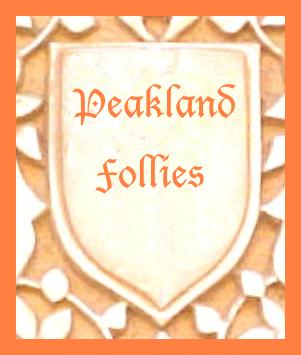6. THE ANCHORAGE CHURCH, FOREMARK
An easy walk alongside the River Trent to an interesting series of rock cut caves.
Getting There: A514 From Swarkestone. After crossing the Trent follow small lane off to right. This leads past a series of flooded gravel pits to a sharp bend at Ingleby. Beyond Ingleby the road leads uphill and runs along the ridge towards Repton. A short way on the main entrance gate to Foremark Hall (Repton School) appears on the right. A short distance further on an unmetalled track leads off left to Foremark Church. Park at the junction with this track. Alternatively park up at Foremark Church.
Distance: 2 miles approx (easy)
Map ref: SK 331 269
Rating:
Walk ** Follies and General Interest **
NOTE. This walk is close to the walk at Swarkestone, both of which may easily be undertaken as part of a day's expedition.
At Foremark, perched on a scarp above the water meadows of the River Trent with sweeping views northwards to the hills of the Peak District, we are truly at the southern terminus of Englands Pennine backbone. If a line must be drawn, this great, wide and swift river, which rises west of the Pennines and empties into the Humber, must mark a boundary as sure as does the Rhine! Here on this long, low ridge, breasted by the Ingleby-Milton road, there is a feeling of quiet charm and a sense of splendid isolation from the industry which is all too evident in the environs of nearby Derby and Burton-on-Trent. There is also an aura of ancient sanctity. Nearby, aloof at the end of a rough farm track St. Saviour's church stands adjacent to the parkland of Foremark Hall. It was mentioned as being a chapel in 1271, but no trace of this now remains, the present church dating from 1662, and being one of the first churches to be built in England after the fall of the Protectorate and the accession of Charles II. But Christianity has far older roots planted hereabouts. Nearby Repton was the capital of the King of Mercia, and it was here that he was converted to the Christian faith. The first bishop of Mercia, Diuma of Lindisfarne, appointed in 656 AD, lived and died at Repton.
Our walk starts at the end of the track leading up to the church. From the lane end follow the main road towards Ingleby a short distance until a waymarked stile appears on the left. (NOT the stile directly opposite the lane end.) A well defined path leads diagonally across an arable field, gradually descending to a track by a plantation. Bear right, and where the track bears left down towards the Trent, continue onwards, passing beneath a line of low crags on the right, surmounted by scrub and trees. Beyond a stile at the base of a gully, the path continues beneath more crags with a large oxbow lake on the left, A short distance on, the Anchorage Caves appear in the crags to the right.

The Anchorite Church and caves, a warren hollowed out of the cliff overlooking a quiet expanse of water, Black Pool, reminds one instantly of the Hermitage at Dale, although this series of rock cut dwellings is far more extensive. Black Pool itself was once part of the course of the Trent, which carved the cliff from the soft sandstone. Today, the Trent lies beyond, its water meadows fading away into the distance, and there is a feeling of peaceful serenity.
According to local tradition this rock dwelling was the home of St Hardulph of Breedon, to whom the church on nearby Breedon Hill is dedicated. It is believed that the caves were first cut sometime during the reign of the pagan King Penda of Mercia (625-655). At this remote spot early Christian hermits would find peace and reflection, and would also be relatively safe from the hand of pagan persecution. Another small cell nearby is known as the 'Anchorite's' larder. Little else is known, and the caves hold their secrets well. An entry in the Parish Register at Repton dated 1658 records that "Ye foole At Anchor Church bur. April 19". We can but speculate who this 'foole' was; perhaps the caves were a once a refuge for those poor deranged souls who in days gone by had to endure the taunts of so called 'normal' folks! By the 18th century, the caves had become a favourite haunt of local gentry, and Sir Robert Burdett, father of the reforming politician Sir Francis Burdett, had the caves enlarged at his own expense. Thus it was that the hermitage of the middle ages became a country gentleman's grotto, used as a dining room for picnic parties from Foremark Hall. The tradition still remains, although today you are more likely to find lager cans, dog ends and smashed cider bottles than fine Madeira Wine!
The Burdetts have been long associated with the Foremark area, and the Anchorage Caves, and a curious legend is associated with them. During the reign of Henry II, one Hugo De Burdett, so the story goes, lived in a castle at nearby Knowle Hill with his wife Johanne. They loved each other dearly, but the Baron of Boyvill, Hugo's kinsman and friend, coveted the lovely Johanne for himself.
His first act was to bribe a local friar named Bernard to con Hugo into embarking on a crusade, thus leaving his wife alone and defenceless (presumably without a chastity belt!). In the Holy Land, Hugo was betrayed to the saracens, and told that his wife was unfaithful and unwilling to pay a ransom for his return. Meanwhile, the crafty baron had informed poor innocent Johanne that her hubby was dead, and that he intended to marry her, whether she liked it or not!
But Boyvill had reckoned without Bernard the friar. Miffed because the Baron had refused to cough up any more money, he sprung Hugo from captivity and informed him that his wife was being unfaithful with his friend. Not long afterwards, the baron, out hunting in the woods around Foremark encountered the understandably angry husband, who promptly resolved the issue with the point of his sword! Having killed the baron, Hugo, mad with jealousy at her supposed deceit, turned on his wife. Drawing his sword, he severed her left hand (upon which she wore her wedding ring) with one savage blow!
Meanwhile friar Bernard, now penitent here at the Anchor Church, was on his deathbed. He called for Sir Hugo, and told him the truth, giving him a parchment which revealed the whole plot against him, and the steadfastness of his wife. In tears Sir Hugo ran to his wife's chamber and there beside the body of his beloved found the altar cloth, embroidered with her own hair which she had been making while praying for his safe return. Legend says that Sir Hugo was led by a nightingale to Ancote in Warwickshire where he built a monastery to atone for his deed. On the altar of this church was placed Johanne's cloth, which it is said had the miraculous power to cure maladies of the hands. It is also said that Sir Hugo's ghost haunts the area, still sorrowing for his wife.
From the Anchorage Church, the path continues onwards between the crags and the lake, which has to be paddled through at one point. Soon a wide concrete footbridge appears on the left, beyond which the path continues alongside the River Trent. which here flows deep and swift. After a stile the path ascends through scrub and pine trees following a fence on the right. The path now becomes a fine high level promenade along the edge of the scarp, with sweeping views over the Vale of Trent. A short distance further on the hamlet of Ingleby appears below, and the path ascends to the right, a wide track between two fences. Just beyond a gated stile on the left, with a path leading down to Ingleby, another gated stile appears on the right. Pass through it and follow a well defined path up the field to a second stile. Beyond, in an area of scrub and trees, the path bears left and follows the fence (left) steeply down to a stile in the gully. Cross the gully and ascend the field on the other side to another stile. Beyond, the path leads diagonally left across another arable field to a gated stile to enter the road just before the entrance gates to Foremarke Hall. From there simply follow the road back to the start of the walk.
Foremarke Hall is now the Repton Preparatory School, as is evidenced by the convoy of fast moving Rollers, Jags, Audis, Range Rovers, Mercs and BMWs that beset the roadwalker if he has the misfortune to be there on a Friday afternoon when the kids are being picked up! The Hall was built by Sir Robert Burdett, the fourth baronet, on the site of an earlier house, in 1755. The present house is built in the Palladian style and was designed by architect David Hiorns of Warwick. In the grounds Sir Robert Burdett planted many holly trees. It is said that while hunting one winter in Needwood Forest, he was entranced by then great number of singing birds. He was told that this was because of the holly trees, whose berries the birds fed on in winter. Thus inspired he planted hollies all over Foremarke! Foremarke's most famous son was of course, Sir Francis Burdett, the radical politician. Born in 1770, and educated at Westminster and Oxford, his 'grand tour' just happened to co-incide with the French Revolution! He heard at first hand as a young man the debates of the French National Assembly, and the politics of revolution must have rubbed off on him, for radicalism was to colour his whole political career. It was Sir Francis who agitated for Parliamentary and penal reform and Sir Francis who was imprisoned for publicly denouncing the Peterloo Massacre in 1819. On numerous occasions he was imprisoned for his advanced views, at one point being locked up in the Tower of London! He died on the 23rd January 1844, having refused food and drink since the death of his wife a few weeks earlier, a sad end for a kind and generous man.
During the First World War Foremarke Hall was used as a military hospital, and in the Second World War it was used by the Army. In 1940 the house was sold to the Prudential Assurance Co. who sold it to the Ecclesiastical Commissioners. Finally it became the Repton Preparatory School, where now the boys play 'rugger' and stroll round 'Baker's Pond' named after that Mr. Baker whose attache case was thrown therein by one of his more recalcitrant pupils! Thus another strand of legend is woven into the mellow tapestry of tranquil Foremark, with its Hall, its Church and its ancient Hermits Cave.........







